Helicopter Pilot Career Series (Part 4): Law Enforcement Helicopter Pilot Careers - Complete Guide to Airborne Public Safety (2025)
Imagine flying 500 feet above a bustling city, your aircraft equipped with cutting-edge thermal imaging and night vision systems, as you coordinate with ground units to track a suspect through winding urban streets. Or picture yourself conducting a life-saving search and rescue mission in remote desert terrain, where your expertise and advanced helicopter technology make the difference between life and death.
This is the reality of law enforcement helicopter pilots—elite aviators who serve as force multipliers for ground officers, providing critical aerial support that has revolutionized modern policing. From high-speed pursuits through Los Angeles's urban canyons to counter-terrorism operations over New York City, these specialized pilots combine advanced flying skills with public safety expertise to protect and serve their communities from above.
If you're considering a career as a law enforcement helicopter pilot, this complete 2025 guide covers everything you need to know about requirements, pilot pathways, top employers, aircraft preferences, compensation, and the evolving future of police aviation careers.
Maryland State Police Night Medevac
Why Law Enforcement Aviation Matters
Law enforcement aviation units have become indispensable to modern public safety operations. These aerial platforms serve as the eyes in the sky, dramatically expanding the reach and effectiveness of ground-based police work through:
Force Multiplication: A single helicopter can cover the same area as dozens of patrol cars, providing real-time intelligence and coordination that transforms how agencies respond to emergencies. The LAPD has consistently defended helicopter use as a force multiplier, demonstrating measurable improvements in response times and suspect apprehension rates.
Life-Saving Capabilities: From emergency medical evacuations to search and rescue operations, law enforcement helicopters save lives daily through rapid response and access to remote locations where ground units cannot reach in time.
Advanced Technology Integration: Modern police helicopters feature sophisticated equipment including forward-looking infrared (FLIR), high-definition camera systems, GPS moving map displays, night vision goggle (NVG) systems, and advanced communication suites that provide unprecedented situational awareness and support precision policing operations.
Public Safety Enhancement: Aerial surveillance and rapid deployment capabilities help prevent crimes, locate missing persons, coordinate complex tactical operations, and provide disaster response with precision that ground units alone cannot achieve.
How to Become a Police Helicopter Pilot: Entry Pathways Explained
The route into law enforcement helicopter aviation varies significantly by agency and state. Understanding these pathways is essential for prospective applicants looking to maximize their chances of success.
TFO-to-Pilot Career Progression
Many agencies require new recruits to begin their airborne careers as Tactical Flight Officers (TFOs)—non-flying crewmembers responsible for operating cameras, FLIR systems, radios, and communicating with ground units. After proving themselves in this role for several years and gaining extensive operational experience, qualified candidates may be promoted to pilot positions internally. This pathway allows departments to evaluate candidates' performance under operational stress before investing in expensive flight training.
Sworn Law Enforcement Officer Pilots
In most municipal and state police departments, pilots must be sworn law enforcement officers with full police powers. This requirement reflects the integrated nature of aviation operations with ground patrol activities.
Typical progression:
- Police Academy: Complete full law enforcement academy training
- Patrol Officer: Serve 3–5 years in ground patrol assignments
- Application to Aviation Unit: Apply for transfer to aviation division
- Flight Training: Complete internal or external helicopter pilot training
This pathway ensures pilots understand ground operations, legal procedures, and law enforcement culture before taking to the skies.
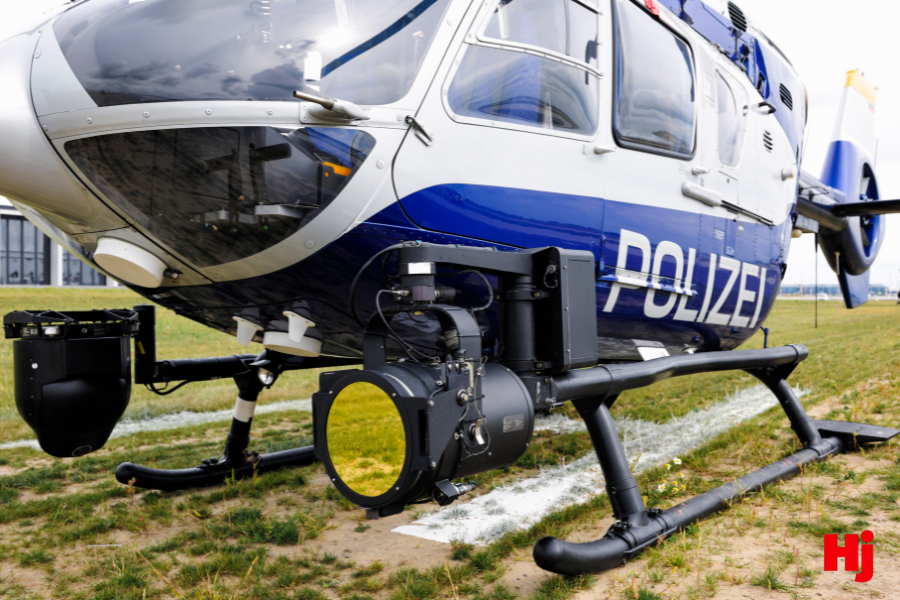
Civilian Pilot Entry (Federal and Select State Roles)
Some agencies—especially federal departments like U.S. Customs and Border Protection (CBP), Department of Homeland Security (DHS), and progressive state agencies like Maryland State Police—allow for direct-hire civilian pilots. These positions often prefer candidates with extensive prior experience in military aviation, emergency medical services (EMS), or offshore operations.
Advantages of civilian pilot positions:
- Focus exclusively on aviation duties
- Typically higher flight hour requirements (1,500–2,500+ hours)
- May offer faster entry for qualified pilots
- Often used in agencies with larger operational budgets and broader mission scopes
Military Pilot Advantage
Former military helicopter pilots, especially those with night vision goggle (NVG), hoist operations, search and rescue (SAR), or multi-mission experience, are often highly competitive applicants. Military backgrounds provide:
- Advanced flight training and discipline
- Experience with complex mission parameters
- Familiarity with night operations and specialized equipment
- Understanding of chain of command and operational procedures
- Fast-track eligibility for both civilian and federal pilot roles
Sworn vs. Civilian Law Enforcement Pilot Careers: Key Differences
Understanding the distinctions between sworn officer and civilian pilot roles is crucial for career planning:
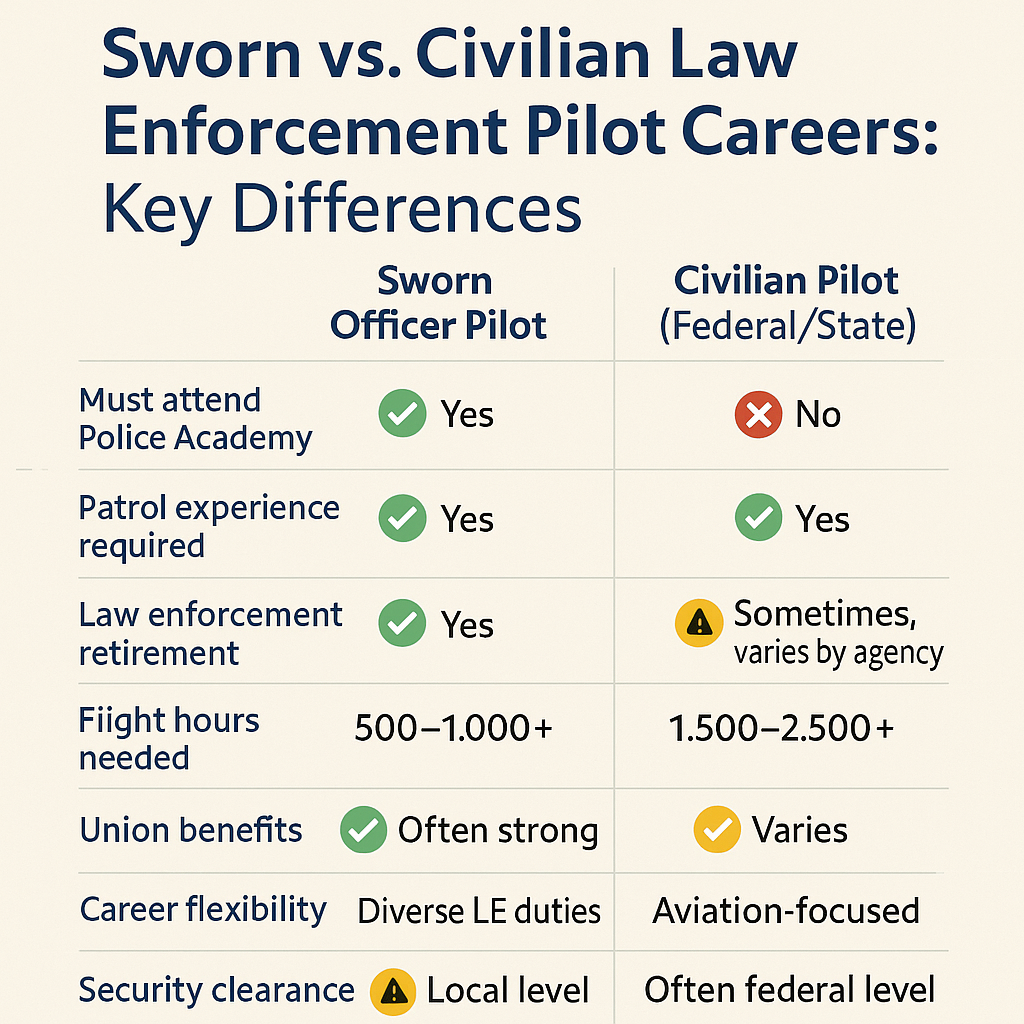
Tip: Always research specific job postings carefully. Some aviation units (like Texas DPS or LAPD) strictly require sworn status, while others (like CBP or Maryland State Police) actively recruit experienced civilian pilots.
Common Barriers to Entry
Despite strong demand for helicopter pilots, several hiring barriers can prevent otherwise qualified candidates from entering law enforcement aviation:
- Sworn Status Requirements: Many city and state departments don't accept civilian pilot applicants
- Age Limits: Some agencies have maximum age restrictions for academy entry (commonly 35–40 years old)
- Medical Qualifications: Must meet Second or First-Class FAA medical requirements and pass agency-specific fitness standards
- Background Checks: Comprehensive investigation including polygraph, psychological evaluations, credit checks, and character references
- Security Clearance: Required for federal roles; may disqualify candidates with certain financial or personal histories
- Vision and Hearing: Must meet stricter-than-average standards for law enforcement aviators
- NVG Certification: Night vision goggle certification increasingly required for modern operations
- Physical Fitness: Ongoing fitness requirements throughout career, particularly for sworn officer positions
Top Law Enforcement Helicopter Employers in the U.S.
LAPD Air Support Division
Fleet: Bell 206 JetRanger, Airbus H125 (AS350 B2/B3) Typical Base: Hooper Heliport, Downtown LA Estimated Annual Flight Hours per Pilot: 300–500 hours
The LAPD operates one of the largest and most prestigious police helicopter units in the United States, commanding a fleet of 17 helicopters. This elite division provides extensive urban aerial support across the sprawling Los Angeles metropolitan area.
What Makes LAPD Unique:
- 24/7 Operations: Multiple aircraft on standby at all times with single-pilot VFR operations in tight urban terrain
- Global Recognition: One of the most active police aviation units worldwide
- Specialized Training: Urban canyon flying, night operations, and coordinated ground-air tactical operations
- High-Profile Missions: Celebrity protection, major event security, Hollywood film industry coordination
- Preferred Aircraft: H125 for its power, maneuverability, and FLIR payload capability
NYPD Aviation Unit
Fleet: Bell 429 Global Ranger, Agusta Westland/Leonardo AW119 Koala
Base: Floyd Bennett Field, Brooklyn
Serving the nation's largest city, the NYPD Aviation Unit operates in one of the busiest and most restricted airspaces in the world. These dual-engine IFR-capable helicopters provide safety and redundancy for critical urban operations.
Mission Highlights:
- Counter-Terrorism Operations: Post-9/11 security protocols and threat response
- Major Event Protection: UN General Assembly, New Year's Eve, presidential visits
- Multi-Agency Coordination: Federal, state, and local law enforcement cooperation
- High-Profile Security: Presidential movements, VIP protection, and international events
CBP Air & Marine Operations
Fleet: Airbus AS350 AStar, Bell UH-60 Black Hawk, MQ-9 Predator, Beechcraft King Air 350
CBP operates one of the world's largest civilian law enforcement air fleets, with over 240 aircraft patrolling more than 7,000 miles of international border.
Operational Scope:
- Border Security: Monitoring and interdicting illegal crossings using advanced surveillance technology
- Drug Interdiction: Long-duration surveillance and interdiction missions with sophisticated sensor packages
- Remote Operations: Challenging terrain and extreme weather conditions from desert heat to arctic conditions
- Technology Leadership: Integration of manned and unmanned aircraft systems
- Civilian and Military Pilots: Accepts experienced pilots from both backgrounds
Maryland State Police Aviation Command
Fleet: Leonardo AW139 (IFR Twin Engine)
Annual Flight Hours per Pilot: 300–600 hours
This multi-mission public safety aviation unit exemplifies the modern integrated approach to law enforcement aviation, conducting over 4,000 missions annually.
Capabilities:
- Multi-Mission Aircraft: Medevac, search and rescue, law enforcement, homeland security
- Advanced Operations: NVG, hoist, and single-pilot IFR missions
- Comprehensive Training: One of the most extensive state aviation programs with rigorous recurrent training
- Statewide Coverage: Base assignments throughout Maryland with diverse operational environments
- Active Recruitment: Currently seeking experienced helicopter pilots with competitive compensation packages
Regional Powerhouses
Phoenix Police Department Aviation Unit: Operates in the challenging desert Southwest environment, utilizing advanced thermal imaging and night vision technology. The extreme heat, dust storms, and mountainous terrain create unique operational challenges requiring specialized training and equipment.
Miami-Dade Police Department Aviation Unit: Specializes in coastal law enforcement missions, including maritime surveillance, drug interdiction, hurricane response, and search and rescue operations. Pilots must be proficient in maritime operations and coordination with the U.S. Coast Guard.
Texas Department of Public Safety (DPS) Aviation Division: Provides statewide coverage across 268,596 square miles—one of the largest geographical responsibilities for any state law enforcement aviation unit, spanning from desert operations to coastal plains.
Helicopters Commonly Flown in Law Enforcement Aviation
Understanding the aircraft types used by different agencies can help pilots with relevant experience target their applications more effectively:
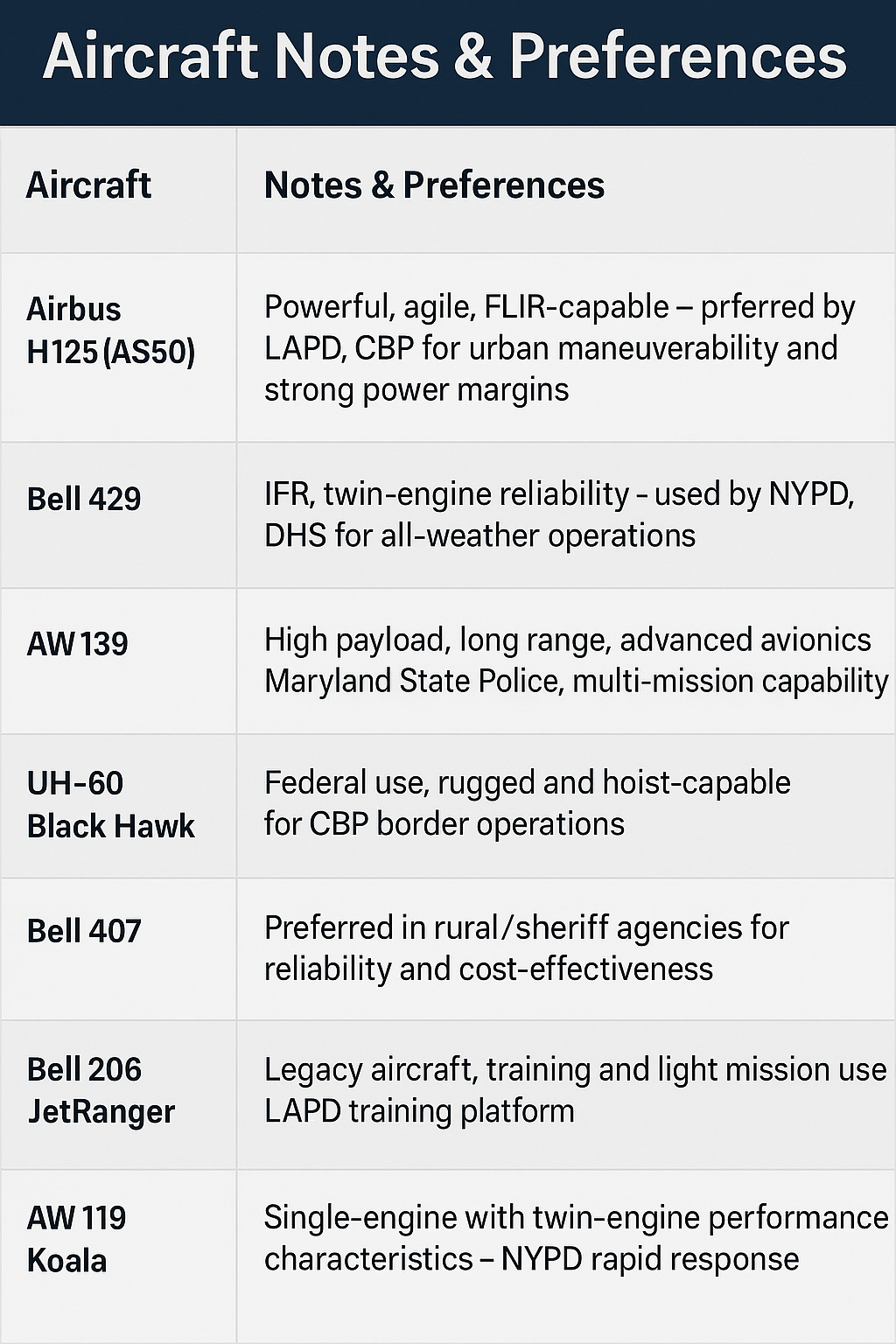
Pilot Preferences: Industry professionals often favor the H125 for its urban maneuverability and strong power margins in hot and high conditions, while AW139 and Bell 429 are valued for IFR capability, twin-engine safety, and advanced avionics in all-weather operations.
Law Enforcement Helicopter Pilot Requirements
Flight Experience Requirements
- Total Flight Time: 1,000 to 2,500+ hours, varying by agency size and mission complexity
- Turbine Experience: 500+ turbine hours recommended (essential for most positions)
- Night Flying: 250+ hours of night flight experience minimum
- NVG Experience: 100+ hours preferred for modern operations
- Instrument Proficiency: Strong instrument flying skills for weather and low-visibility operations
- Specialized Experience: Mountain flying, confined area operations, and urban environment experience highly valued
Essential Licenses and Certifications
- FAA Commercial Rotorcraft License with Instrument Rating (non-negotiable requirement)
- Medical Certificate: First or Second-Class appropriate for commercial operations
- NVG Certification: Required for night operations in most modern agencies
- Additional Ratings: May include specific aircraft type ratings or flight instructor certificates
Background and Security Requirements
Law enforcement aviation demands the highest levels of personal integrity:
- Criminal Background: No felony convictions, completely clean record with extensive background investigation
- Security Clearances: Ability to obtain and maintain various levels of security clearance
- Polygraph Examination: Standard requirement for most agencies, including federal positions
- Psychological Evaluation: Comprehensive assessment of mental fitness and stress management capabilities
- Drug Screening: Initial screening plus ongoing random testing throughout career
- Credit and Financial Review: Assessment of financial responsibility and potential security risks
Physical and Personal Requirements
- Physical Fitness: Comprehensive fitness assessments, particularly for sworn officer positions
- Vision and Hearing: Excellent sensory capabilities for high-stress operations
- Stress Management: Demonstrated ability to perform under extreme pressure and make rapid decisions
- Communication Skills: Clear, precise communication with multiple agencies and air traffic control
- Night Vision Equipment: Capability to wear and operate effectively with NVG systems
Helicopter Pilot Salary: Law Enforcement Jobs by Agency
Law enforcement helicopter pilots enjoy some of the most competitive compensation packages in aviation, with industry data showing police helicopter pilots averaging $109,676 annually, and specialized law enforcement positions reaching $130,916.
Federal (CBP, DHS, FBI):
$95,000 – $150,000+
GS pay scale, plus overtime and hazard pay; full federal benefits.
State (MSP, Texas DPS):
$75,000 – $115,000
Excellent benefits, state pension, and active hiring bonuses.
City (LAPD, NYPD, Phoenix):
$70,000 – $110,000
Overtime can add $15,000–$40,000 annually in major metro areas.
Enhanced Compensation Factors
Overtime and Hazard Pay: Can increase total compensation by $10,000-$30,000+ annually through:
- Emergency response operations and extended missions
- Holiday and weekend premiums
- Special event security assignments
- Training and certification instructor pay
Specialized Assignment Bonuses include:
- SWAT team support operations
- Counter-terrorism unit assignments
- Multi-agency task force participation
- Shift differentials for night and weekend operations
Law Enforcement Retirement Benefits:
- 20-25 Year Retirement Eligibility: Often with full pension and medical coverage
- Pension Calculations: Based on highest earning years
- Healthcare for Life: Continued medical coverage after retirement
- Social Security: Additional retirement income beyond pension
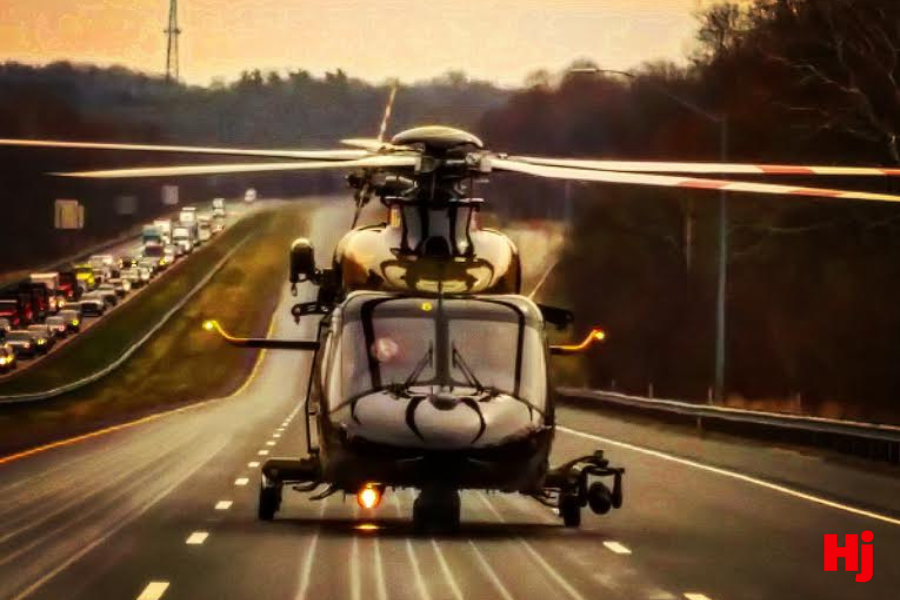
Types of Missions Law Enforcement Pilots Fly Daily
Law enforcement helicopter pilots operate across an incredibly diverse range of missions, each requiring specialized skills and presenting unique challenges.
Tactical and Pursuit Operations
- SWAT Overwatch: Providing aerial surveillance and insertion capabilities for high-risk warrant service, barricaded suspect situations, and active shooter responses
- High-Speed Vehicle Pursuits: Coordinating with ground units during chases, providing continuous tracking when ground units must discontinue pursuit for safety
- Foot Pursuits: Tracking suspects through complex urban terrain or wilderness areas where ground officers cannot maintain visual contact
- Barricaded Subject Surveillance: Extended operations providing intelligence during lengthy standoff situations
Search and Rescue (SAR) Operations
- Missing Persons: Locating lost hikers, children, elderly persons with dementia using thermal imaging and grid search patterns
- Disaster Response: Hurricane, wildfire, flood, and earthquake response including victim location and evacuation operations
- Emergency Medical Transport: Rapid transport from remote terrain to trauma centers, often coordinating with EMS services
- Hoist Operations: Technical rescue operations in mountainous or coastal regions requiring specialized equipment and training
Surveillance & Intelligence Gathering
- Organized Crime Investigations: Long-duration covert surveillance flights supporting narcotics and organized crime investigations
- Drug Interdiction Operations: Supporting DEA and local narcotics units with aerial surveillance and coordination
- Multi-Agency Task Forces: Working with FBI, DEA, ATF, and other federal agencies on joint operations requiring security clearances
Major Event Security
- Political Events: Presidential visits, political conventions, and VIP protection requiring extensive coordination with Secret Service
- Sports Venues: Super Bowl, World Series, and major sporting events with crowd monitoring and security overwatch
- Protests and Civil Events: Constitutional protection while maintaining public safety during demonstrations
- Counter-Terrorism Overwatch: Major gathering security including New Year's Eve celebrations and public festivals
Advanced Technology Integration
Modern law enforcement helicopters represent some of the most technologically advanced aircraft in civilian aviation, requiring pilots to master complex systems while maintaining safe flight operations.
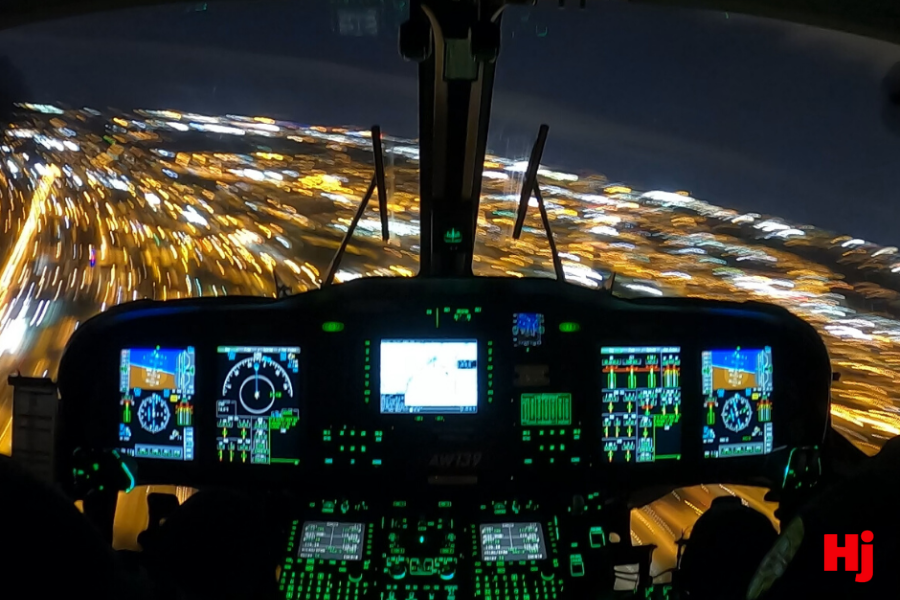
Essential Aircraft Systems
- Forward-Looking Infrared (FLIR): Thermal imaging systems for night operations, suspect tracking, and search operations requiring understanding of thermal signatures and optimal positioning
- High-Definition Camera Systems: Gyro-stabilized cameras with powerful zoom capabilities for evidence gathering and real-time surveillance
- Electronic News Gathering (ENG) Systems: Microwave and satellite downlinks providing real-time video transmission to command centers and ground units
- GPS Moving Map Displays: Advanced navigation systems integrated with agency databases and restricted area warnings
- Advanced Communication Suites: Multi-frequency radio systems enabling simultaneous communication with ground units, air traffic control, and federal agencies
Mission-Specific Equipment
- Night Vision Goggle (NVG) Systems: Essential for covert operations and low-light missions, requiring specialized training and regular proficiency checks
- Searchlight and Illumination Systems: High-intensity lighting for suspect identification and crime scene illumination
- Hoist and Rescue Equipment: Mechanical winches and rescue baskets for emergency medical evacuations and technical rescue operations
- Tactical Equipment Mounts: Weapon mounts, less-lethal device deployment systems, and specialized tactical equipment integration
Career Development and Future Outlook
Career Growth Paths Within Law Enforcement Aviation
- Lead Pilot Positions: Advancement to senior pilot roles with increased responsibilities and flight operations oversight
- Training Officer Roles: Development into instructor pilot positions, check airman responsibilities, and academy training assignments
- Aviation Unit Supervisor: Management positions overseeing flight operations, budget management, and personnel supervision
- Cross-Agency Transitions: Movement from municipal to federal positions (e.g., local police to CBP) with enhanced compensation and benefits
- Specialized Unit Assignments: Elite teams including counter-terrorism units, federal task forces, and international cooperation programs
Industry Career Transitions
The experience gained in law enforcement aviation is highly valued throughout the helicopter industry:
- Emergency Medical Services (HEMS): Customer service skills and emergency response experience translate directly
- Offshore Oil and Wind Energy: Precision flying skills and experience with advanced avionics prepare pilots for lucrative offshore positions
- Corporate VIP Flying: Professional presentation skills and VIP passenger experience open doors to executive transport
- Flight Training and Instruction: Teaching abilities developed through crew coordination and passenger briefings
- Aircraft Manufacturing: Test pilot positions and technical representative roles leveraging operational knowledge
Industry Outlook and Opportunities
Current Challenges:
- Critical Pilot Shortage: Aging workforce, airline recruitment, reduced military training pipelines, and high training costs
- Recruitment Competition: Airlines and offshore operators offering enhanced compensation and signing bonuses
- Training Pipeline Constraints: Limited flight training capacity creating bottlenecks in pilot development
Emerging Opportunities:
- Enhanced Compensation: Agencies responding with increased base salaries, signing bonuses, retention bonuses, and accelerated advancement
- Technology Integration: Advanced systems creating opportunities for UAS operations, artificial intelligence integration, and enhanced surveillance capabilities
- Expanding Mission Scope: New operational areas including cybersecurity, environmental monitoring, emergency management, and international cooperation
- Strong Job Security: Public safety aviation provides recession-proof employment with excellent government benefits
Getting Started: Your Complete Roadmap
Phase 1: Foundation Building (0-500 hours)
Essential Licenses and Ratings:
- Private Pilot License (Helicopter)
- Commercial Pilot License (Helicopter)
- Instrument Rating (absolutely essential)
- Build initial flight time through instruction, tours, or utility operations
Professional Development:
- Develop strong communication and teamwork abilities
- Gain customer service experience
- Build technical system knowledge
- Maintain excellent physical fitness
Phase 2: Experience Building (500-1,500 hours)
Accumulate Quality Flight Time:
- Tour operations for rapid hour building
- Emergency Medical Services experience
- Utility and construction flying
- Flight instruction positions
- Night flying and instrument proficiency
Enhanced Qualifications:
- Get NVG Certified: Increasingly essential for modern operations
- Multi-engine helicopter ratings
- Specialized training certificates (mountain flying, confined areas)
- Advanced avionics and glass cockpit experience
Phase 3: Career Preparation (1,000+ hours)
Meet Background Requirements:
- Maintain completely clean criminal record
- Establish solid credit history and financial responsibility
- Develop strong community connections and character references
- Consider military service or law enforcement experience
Professional Networking:
- Connect with current law enforcement pilots through industry events
- Attend aviation conferences and job fairs
- Visit agency open houses and recruitment events
- Develop relationships with aviation training organizations
Application Strategy
Research Target Agencies: Identify departments actively hiring that match your qualifications, career goals, and geographic preferences.
Application Preparation: Develop comprehensive packages including detailed flight experience records, professional aviation references, clean background documentation, and current medical certificates.
Interview Excellence: Prepare for extensive processes including technical flying knowledge assessments, scenario-based decision making questions, background investigation interviews, and psychological evaluations.
Ready to Launch Your Career?
You'll Thrive in Law Enforcement Aviation If You:
- Want to protect communities through advanced aviation technology
- Can operate effectively under pressure and make rapid, sound decisions
- Value job security, professional camaraderie, and meaningful public service
- Appreciate flying sophisticated, mission-equipped helicopters with cutting-edge technology
- Possess strong moral character, integrity, and commitment to excellence
- Enjoy diverse, challenging missions that make a real difference in people's lives
Consider Alternative Paths If You:
- Prefer predictable, routine schedules without emergency call-outs
- Are uncomfortable with ongoing background scrutiny and security requirements
- Cannot commit to shift work, nights, weekends, and holiday assignments
- Are unable to meet strict physical, mental, and medical health requirements
- Prefer purely technical flying without public safety responsibilities and mission pressure
The Bottom Line
Law enforcement helicopter aviation represents one of the most challenging, rewarding, and secure career paths in the aviation industry. With critical pilot shortages creating unprecedented opportunities, agencies enhancing compensation packages, and technology continuing to advance mission capabilities, there has never been a better time to pursue this elite aviation career.
The men and women who serve as law enforcement helicopter pilots represent the best of both aviation and public safety professions. They combine advanced flying skills with unwavering dedication to protecting and serving their communities from above. If you possess the required skills, character, and dedication, law enforcement aviation offers a career that is both personally fulfilling and professionally rewarding.
Ready to Take Off?
Visit Helicopter-Jobs.com to explore current openings with police departments, sheriff's offices, state agencies, and federal law enforcement organizations across the United States.
Your mission to serve and protect from above starts now. The skies are calling—will you answer?
